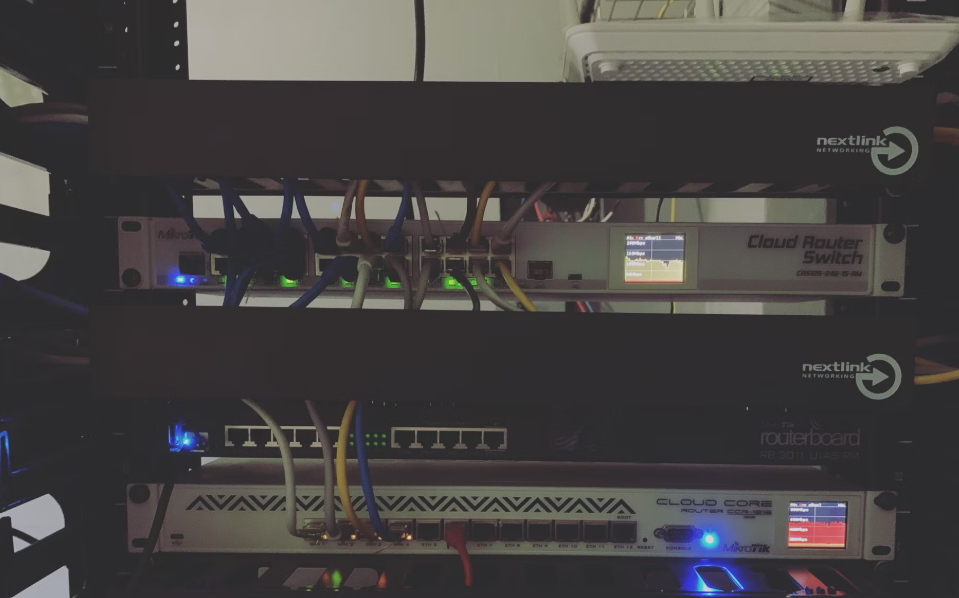From DSL to Fibre: The Evolution of Business Internet Services
-
January 23, 2025
-
10 min read

The evolution of business internet services has been marked by significant advancements, transitioning from the limited bandwidth and reliability of Digital Subscriber Line (DSL) technologies to the robust, high-capacity capabilities of fibre-optic solutions. This transformation is underscored by a shift towards greater data throughput and minimal latency, crucial for modern business operations that demand real-time data exchange and cloud computing efficiency.
Fibre optics leverage the principle of total internal reflection, enabling light transmission over considerable distances without the signal degradation typically observed in metallic conductors.
This blog gets into the technological underpinnings that facilitated this shift, exploring the materials science, signal integrity considerations, and infrastructural developments that have redefined the landscape of enterprise connectivity solutions.
The Early Days of Internet Services
The dawn of internet services marked a transformative era in connectivity, laying the foundational stones for today’s digital landscape.
Understanding Dial-up Connections
Dial-up internet utilised traditional telephone lines for internet access, symbolising the beginning of online connectivity. Key aspects of dial-up include:
- Initial Connection: Users manually connected to the internet by dialling a number, which often resulted in busy lines.
- Speed Limitations: The speeds were typically up to 56 kbps, making the internet slow, especially for downloading large files.
- Line Occupation: The internet connection occupied phone lines, preventing any calls during internet sessions.
- Widespread Availability: It was widely available, requiring only a modem and existing phone line.
The Shift to DSL: A Major Leap Forward
The introduction of Digital Subscriber Line (DSL) technology was a pivotal advancement in the evolution of business internet services. DSL brought significant improvements:
- Enhanced Speeds: DSL offered speeds significantly higher than dial-up, beginning at 128 kbps and reaching up to several Mbps.
- Simultaneous Usage: Users could access the internet and make phone calls simultaneously, a major advantage over dial-up.
- Infrastructure Utilisation: DSL also used existing telephone lines but separated data for internet and voice, reducing interference.
- Reliability and Stability: It provided more reliable and consistent connections, crucial for businesses relying on stable internet access.
These developments represented critical steps in the evolution of internet services, drastically enhancing user experience and accessibility, thereby setting the stage for the high-speed broadband technologies that followed.
DSL Technology and Its Impact
Digital Subscriber Line (DSL) technology revolutionised internet access by significantly improving speeds and reliability over traditional dial-up connections.
How does DSL Work?
DSL transmits digital data over standard copper telephone lines. Here’s how it operates:
- Utilising Existing Infrastructure: DSL uses the same telephone lines as voice calls but operates so that data and voice can coexist without interference.
- Modulation Techniques: It employs sophisticated modulation schemes to pack data onto copper wires.
- Splitting Frequencies: DSL splits the line into three channels—voice, download, and upload—which allows simultaneous phone use and internet browsing.
- Constant Connection: It provides an ‘always on’ connection, eliminating the need to dial up each time.
Advantages of DSL for Early Business Applications
DSL’s capabilities provided several advantages for businesses, streamlining operations and enhancing connectivity. Key benefits include:
- Higher Bandwidth: Compared to dial-up, DSL offers higher bandwidth, facilitating faster data transmission crucial for business operations.
- Reliability: It offers more stable and reliable connections, a necessity for businesses that rely on constant internet availability.
- Cost-Effectiveness: While offering significant improvements over dial-up, DSL does not require significant infrastructure changes, making it a cost-effective solution.
- Scalability: Businesses can choose from various DSL types, like ADSL, SDSL, and VDSL, each providing different speeds and services to meet specific needs.
These advancements made DSL a preferred choice for early business applications, setting the foundation for modern broadband solutions and significantly impacting how businesses operate online.
The Rise of Broadband Technologies
The evolution of broadband has dramatically reshaped internet access, offering faster speeds and more reliable connections across different technologies.
Cable Internet: Speed and Accessibility
Cable internet emerged as a powerful player in the broadband landscape due to its use of existing cable television infrastructure. Here are the key points:
- High-Speed Access: It provides high-speed internet access through coaxial cables, much faster than DSL.
- Shared Bandwidth: The bandwidth is shared among users in the same area, which can affect speeds during peak times.
- Installation: It typically requires professional installation of a modem and connection to the nearest cable node.
- Widespread Availability: Cable internet is widely available in urban areas, making it a popular choice for both residential and business users.
The Role of Satellite Internet in Remote Areas
Satellite internet plays a crucial role in providing connectivity to remote and rural areas where terrestrial broadband options are limited or non-existent. Important aspects include:
- Global Coverage: Satellite internet covers areas beyond the reach of cable and DSL, offering global connectivity.
- Independent Infrastructure: It operates independently of terrestrial infrastructure by transmitting data via satellites in orbit.
- Latency Issues: The technology faces higher latency due to the long distance data must travel from the earth to the satellite and back.
- Weather Dependence: Signal quality and connection stability can be affected by weather conditions, which is a notable drawback.
These broadband technologies have expanded the frontiers of internet access, making high-speed connections available in diverse environments and playing pivotal roles in the ongoing digital transformation.
Transition to Fibre Optics
The shift to fibre optics marks a significant leap forward in the evolution of business internet services, providing unprecedented speed and reliability.
Fibre Optic Technology Explained
Fibre optic technology harnesses the power of light to transmit data at speeds far surpassing traditional methods. Key aspects include:
- Light-based Transmission: Data travels as light pulses inside glass or plastic fibres, enabling extremely fast data transfer rates.
- Minimal Signal Loss: fibre optics experience less signal loss over long distances compared to copper cables, enhancing long-range communication.
- Bandwidth Capacity: The fibres can carry vast amounts of data, making them ideal for modern high-demand applications.
- Durability and Interference: Unlike copper cables, fibre optics are immune to electromagnetic interference and are more durable under physical stress.
Comparing Fibre to DSL and Cable
When comparing fibre optics to DSL and cable, several distinctions become clear:
- Speed: fibre optics offer speeds up to 1 Gbps, significantly faster than the maximum 100 Mbps typically available with DSL and the 300 Mbps of cable.
- Reliability: fibre optic cables are less susceptible to weather conditions and electrical interference, which can affect both DSL and cable.
- Latency: fibre optics have lower latency than DSL and cable, benefiting real-time applications like online gaming and video conferencing.
- Scalability: The infrastructure of fibre optics is more easily scalable, allowing for upgrades without extensive changes to the core network.
This transition is transforming internet connectivity, making it faster, more reliable, and ready to meet future digital demands.
The Global Spread of Fibre Internet
The expansion of fibre internet across the globe signifies a major evolution in connectivity, enhancing speed and access in various regions.
Fibre Deployment in Urban V. Rural Areas
Fibre internet deployment varies significantly between urban and rural areas. Here are the key differences:
- Urban Deployment: In cities, the dense population makes it economically viable to install fibre infrastructure. Urban areas often see quicker deployment and higher speeds due to the potential for higher returns on investment.
- Rural Deployment: Rural areas face challenges such as higher costs and lower population density, which can delay fibre rollout. The distance between properties also increases the installation complexity and expense.
- Technological Solutions: To address these issues, some providers use hybrid approaches, combining fibre with other technologies like wireless to extend reach without full fibre cabling.
- Impact on Access: While urban residents may enjoy gigabit speeds, rural areas often lag behind, which can affect local economies and access to digital services.
Government Initiatives and Private Investments
Government policies and private sector investments play crucial roles in the spread of fibre internet. Key initiatives include:
- Government Funding: Many governments offer grants, subsidies, or public-private partnerships to encourage fibre rollout, especially in underserved areas. These initiatives aim to reduce the digital divide and boost national connectivity.
- Private Investment: Telecommunication companies are investing heavily in fibre infrastructure to meet growing demand for high-speed internet. These investments are often focused on competitive markets with high potential for customer uptake.
- Regulatory Frameworks: Effective regulation is critical to foster competition and ensure fair access to infrastructure, which can accelerate fibre deployment.
This global push towards fibre internet is transforming how individuals and businesses connect, offering vast improvements in speed, reliability, and the overall quality of internet services.
Challenges in the Evolution from DSL to Fibre
The transition from DSL to fibre internet presents numerous challenges, despite the clear advantages of the latter in speed and reliability.
Infrastructure and Investment Challenges
The shift to fibre optics involves substantial infrastructure and investment challenges. Key issues include:
- High Upfront Costs: Laying down fibre-optic cables involves significant initial investment compared to using existing DSL lines. The cost is especially high in urban areas where civil work can disrupt daily activities.
- Technical Complexity: Installing fibre requires more advanced technical skills and equipment than traditional copper wire installations. This complexity can lead to longer deployment times and higher labour costs.
- Existing Infrastructure: In many areas, the existing telecommunications infrastructure is deeply entrenched, and the shift to fibre can be slow due to the need to overhaul or integrate with old systems.
- Return on Investment: For many service providers, the high cost of deployment can be a deterrent unless there is a guaranteed return on investment, which can be uncertain in less populated or already well-serviced areas.
Addressing the Digital Divide
Transitioning to fibre also highlights the issue of the digital divide between different socioeconomic and geographic areas. Here’s how this challenge is being addressed:
- Policy Initiatives: Governments are implementing policies to incentivise fibre rollout in underserved areas, including subsidies and grants. These initiatives aim to ensure that all citizens have access to high-speed internet.
- Public-Private Partnerships: Collaboration between the public and private sectors can help spread the cost and risk associated with new infrastructure projects. These partnerships are crucial in extending fibre connectivity to remote or economically disadvantaged areas.
- Community Projects: Some regions benefit from local or community-driven projects that aim to bring fibre internet to their area. These projects often receive support from local governments or non-profit organisations.
- Educational Programs: Educating communities about the benefits of high-speed internet can increase adoption rates and encourage investment in fibre technology. Education also helps communities make the most of the new technology once it’s available.
These challenges require a coordinated approach involving governments, private companies, and communities to ensure that the transition from DSL to fibre results in equitable internet access for all.
Expanding Business Connectivity with Airtel Office Internet Services
For businesses seeking a tailored internet solution that aligns with the demands of modern enterprise operations, Airtel Office Internet (AOI) stands out as a strategic choice. AOI provides comprehensive connectivity options ranging from 40 Mbps to 1 Gbps, ensuring high-speed access tailored to diverse business needs.
Each plan includes valuable add-ons such as static IP addresses, and advanced security features, enhancing productivity and safeguarding business data. With its robust support and reliable fibre optic connections, Airtel Office Internet Services offer a corporate postpaid package designed for the dynamic requirements of today’s businesses.
Embracing the Future of Connectivity
The evolution of business internet services has seen tremendous growth, transitioning from basic broadband to advanced fibre optics like leased lines that offer unprecedented speed and reliability. This progression is integral to supporting the increasingly complex demands of modern businesses, such as cloud computing, extensive data transfer, and real-time communication.
For enterprises looking to leverage these advancements, Airtel Office Internet (AOI) provides an exemplary service. AOI’s comprehensive offerings, including high-speed plans, enhanced security measures, and value-added features, make it a top choice for businesses aiming to optimise their internet connectivity and embrace the full potential of digital transformation.
 Share
Share









